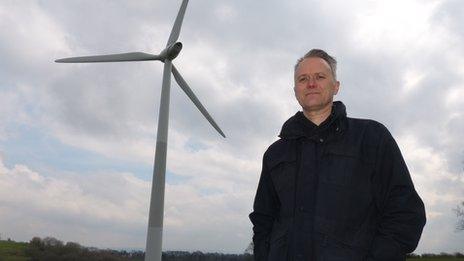How new Peer-to-Peer ISAs could double your returns
- Published
Brian Milligan explains how Peer-to-Peer lending works
How could savers, the new darlings of George Osborne, make better returns?
Those who buy cash ISAs over the next few weeks will be lucky to make 2% a year.
But from 2015 investors might be able to double or even treble those returns if they take out one of the new Peer-to-Peer ISAs.
Announced by the chancellor in the budget, the Peer-to-Peer ISAs will allow you to lend your cash to an individual or a business and pocket the interest payments tax-free.
Since those payments can provide an annual return of as much as 8%, millions of savers should really benefit.
But unlike cash ISAs, there is an element of risk.
'Feel-good' factor
Imagine a scenario in which you play the role of a bank manager. You decide how much risk you want to take with your money, and the amount you will charge to lend it out.
Then you can decide who you will lend it to, be that an individual who wants to buy a new car or a business that wants to expand.
Finally, like the aforesaid bank manager, you can take to the golf course while your interest payments roll in.

Andy Smith is getting a return of up to 8% on his local wind turbine
When Andy Smith, for example, heard of plans for a new wind turbine near his village in Gloucestershire, he decided to put some of his own money into the project.
In return for £750, he now earns cash payments of 7-8% a year.
"It's got a feel-good factor on both levels," he tells the BBC.
"Obviously I'm helping the environment, and a green sustainable future, but for the bank balance it's great as well."
The project, run by a crowdfunding platform called Abundance, should be eligible for ISA status next year.
Risks
To protect themselves against the risk of borrowers defaulting, most lenders spread their loans over at least 100 individuals or businesses.
John Davies signed up with the peer-to-peer lender Funding Circle six months ago, and has already lent money to nearly 500 small companies.
"My average annual return over that period is 6.5%," he says.
"So compare that to anything you might get in a bank, and of course that's very favourable."
But this sort of lending - to businesses - is riskier than lending to individuals. In the case of Funding Circle, 1.4% of loans never get repaid.
And unlike cash ISAs, your money is not protected under the Financial Services Compensation Scheme.
"Your capital, absolutely, is at risk," says Julia Groves, the chair of the UK Crowdfunding Association.
"But the particular type of investment which Her Majesty's Treasury are going to allow into ISAs is controlled. And you only qualify if you are an established business with a track record of servicing debt."
In any case, several peer-to-peer lending platforms offer protection from bad debt.
Zopa has what it calls its Safeguard Fund, and Ratesetter has a Provision Fund. It boasts that no saver "has ever lost a penny", despite 10,000 lenders being involved over a three-year period.
New rules
From 1 April, the Financial Conduct Authority (FCA) will become the new regulator for loan-based crowdfunding.
That includes platforms like Zopa, the Funding Circle and Ratesetter, which will all be eligible for ISA status from some time in 2015.
Under the FCA's new rules, even if the platform itself collapses, the loans will continue, thus protecting both the investor and the borrower.
There are also requirements about the amount of capital such platforms must hold, to prevent their collapse in the first place.
However, so-called investment-based crowdfunding, which the FCA already regulates, is in a different category.
This is where investors buy shares in an unlisted company or start-up.
'Sophisticated'
Such investments are far more risky.
In this category, the FCA says that more than 50% of the firms involved will fail in the first five years.
In other words, there is a greater chance of an investor losing money than making it.
So here too, the FCA is introducing new rules to protect investors.
For those who are not professionals, anyone investing in these shares has to be what is termed "sophisticated", or wealthy.
Everyone else has to promise not to risk more than 10% of their investment pots on such products.
However, anyone who buys such shares twice in a two-year period can claim to be "sophisticated," and so escape the 10% restriction.